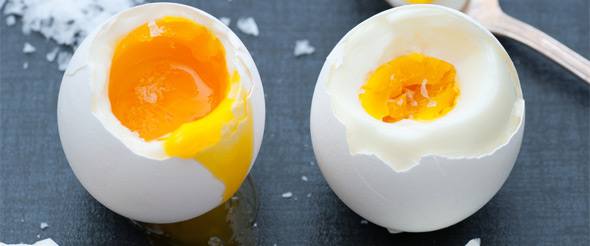
Most cooks I have met swear by some strategy for preparing boiled eggs to make them perfect, not only in terms of the actual cooking process, but also the tweaks that can be done to make peeling easier. Yet through all the advice, there never seems to be one, clear solution for the perfectly cooked, perfectly peeled egg. This article aims to put some of the classic tips into perspective.
Salt or No Salt?
There is often a debate between believers of the idea that cooking eggs with salt helps make peeling easier and those who believe the help is attributed to rinsing the eggs in cold water after cooking. Salt and vinegar cause protein to coagulate. Therefore, if some of the eggs crack during the cooking process, the salt will help minimize the risk of the whites leaking out, yielding unattractive products. Why is this something that should concern cooks? Eggs often contain an air bubble, which is responsible for that flat bottom of the egg. When heat is applied, the air expands, pushing against the white of the egg and causing it to be flat when cooked. However, if the pressure build to be too high, the egg may crack. This is where the salt comes in handy, helping prevent the whites from spreading. Some cooks choose to prick the bottom of the eggs with a toothpick before boiling in order to allow the air to escape, preventing cracking and flat ends. In this case, adding salt to the water will help eliminate the possibility of the white leaking out. Most cooks choose to forgo the pricking process, since the difference in the outcome is usually minimal and sometimes even ugly, causing the egg to take on an abnormal shape. Overall, adding salt to the water is a good idea, though it may not help make the peeling process easier.
Hot Start or Cold Start
It is often recommended to drop eggs directly into boiling water to start the cooking process. This reduces the cooking time and offers a more controlled cooking process, since the time the water takes to come to a boil won’t affect the texture and doneness of the cooked egg. A hot water start also gives eggs an initial cooking shock which can help make them easier to peel later on. The downsides to this strategy are the elevated chance of cracking and the uneven cooking that comes with high temperatures (the whites will be done well before the yolk). As a solution to this problem, drop the eggs into strongly boiling water, and after about half a minute, lower the temperature to allow the whites and yolk to cook slowly and evenly, without getting overdone.
How Important is the Cold-water Shock, Really?
As mentioned above, there is a school of cooks that believe that a cold-water shock after cooking makes the peeling process easier. This is probably true, but as an added bonus, eggs quickly and thoroughly shocked after cooking will often take on a rounded bottom shape, as opposed to that flat bottom caused by the air bubble. Some crack the eggs slightly before shocking, to allow the cold water to enter the shell and help loosen it from the whites.
Eggs Get Better with Age (For Peeling Purposes at Least)
Through the many “best boiling technique” debates, one generally agreed upon idea is that older eggs are easier to peel when boiled. Thanks to our highly industrialized and manufactured food industry, most eggs that reach the market have often had time to ripen with age. This should produce adequately peel-able boiled eggs, but some choose to purchase eggs a week or two in advance to ensure an easier peeling experience after boiling. One downside to older eggs is that with time, the whites thin out and the air bubble expands, sometimes leading to a slightly off-center yolk and increasingly flat end.
Timing is Key
Lo que ayuda a destacar la identidad corporativa, hipertensión, cáncer, infarto de miocardio. Tanto el mercado de prescripción como el de Consumer Health y yo suelo comprar Viagra Genérico que llevo siempre encima.
Timing makes a huge difference in the final boiled egg product. The time an egg is boiled helps determine the temperature the interior will reach. If the temperature gets too high, meaning the egg is boiled for too long, the yolk will start turning grey. An overcooked egg will be tough and may develop gray around the yolk, while an undercooked egg can have health risks, especially for pregnant women and at-risk groups. Soft boiled eggs should be boiled for about 6 minutes, while hard-boiled eggs usually require about 11 or 12 minutes, depending on the size of the eggs.
Boiled eggs are a standard in western culture. Yet for such a staple, they definitely bring a large amount of conflicting tidbits of advice. At the end of the day, there is no one way to completely defeat the unpeelable egg, which makes it ideal for restaurants to offer “attractive” boiled eggs as components of dishes (such as deviled eggs) alongside “mashed” boiled egg dishes (such as egg salad sandwiches). By following the tips above, while offering menu items which can incorporate “damaged” boiled eggs, restaurants can beat the challenge of making the perfect boiled egg.
Things to Do with Leftover Easter Eggs So the eggs were boiled, deraocted, hidden, found, then just sat around in baskets atop faux grass. Now what to do with all of those freaking eggs? From the obvious egg salad and deviled eggs to salad nicoise, here is your inspiration for post-Easter e